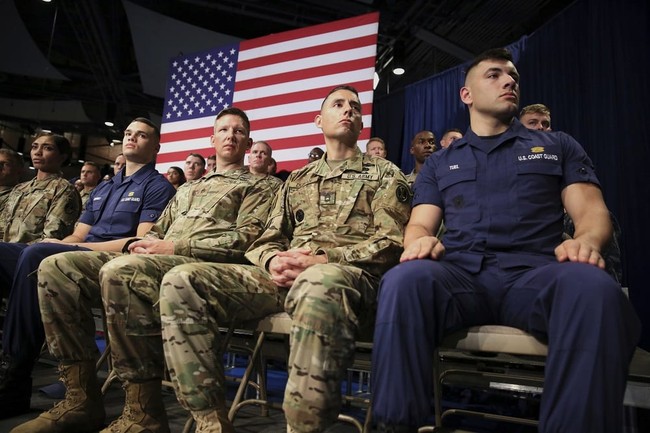
Members of the U.S. Military listen as President Donald Trump speaks at Fort Myer in Arlington Va., Monday, Aug. 21, 2017, during a Presidential Address to the Nation about a strategy he believes will best position the U.S. to eventually declare victory in Afghanistan. (AP Photo/Carolyn Kaster)
Last night President Trump gave a speech on the way forward in Afghanistan. He stuck to the text of his speech and I think did a creditable job as evidenced by various Breitbart writers spewing blood out of their whatevers.
The Washington Post has already criticized the strategy as being short of specifics. This says more about the utter stupidity and raw partisanship of the reporter. Strategy, by definition, is a general outline of principles. The Casablanca Conference that laid out the strategy for the war in Europe was a series of agreements of actions to be taken with no dates affixed to them. And, as a general rule one does not announce all details of a strategy publicly because the enemy often reads our newspapers…when not dictating content.
Trump did not have an easy task. The Afghan war has dragged out for 16 years. In 2019, we will deploy young infantrymen to Afghanistan who were not even born when the Twin Towers came down. The reasons for this are numerous. First and foremost, Afghanistan is not a nation-state, it has no competitive economic advantages, it is backward, barbarous, and corrupt. It has no history of effective central government or of civil society. It is f***ed. Not only was Afghanistan a basket case, neither the Bush nor the Obama administration could decide what it wanted to do. Were we there to kill terrorists and leave? Or were we trying to leave behind a functioning society?
Here are some high points of the speech as I saw them.
My original instinct was to pull out — and, historically, I like following my instincts. But all my life I’ve heard that decisions are much different when you sit behind the desk in the Oval Office; in other words, when you’re President of the United States.
This is a major concession and positive one. It won’t please the Trump haters who will dance their little Macarena and point out that he has gone back on a campaign pledge. Of course, if he had pulled out they would have danced their little Macarena and crowed about how Trump was putting campaign pledges above national security. The recognition that we have equities at stake and those equities are more significant than a gut feeling and campaign rhetoric is a good sign coming from Trump.
These are the equities Trump sees involved:
First, our nation must seek an honorable and enduring outcome worthy of the tremendous sacrifices that have been made, especially the sacrifices of lives.
I’m not sure how much I agree with this. There is such a thing as throwing good money after bad but I can’t gainsay him placing a priority on honoring those who have served by not losing this fight.
Second, the consequences of a rapid exit are both predictable and unacceptable. 9/11, the worst terrorist attack in our history, was planned and directed from Afghanistan because that country was ruled by a government that gave comfort and shelter to terrorists. A hasty withdrawal would create a vacuum that terrorists, including ISIS and al Qaeda, would instantly fill, just as happened before September 11th.
Trump is catching some flack from Obama apologists over this but he’s right. Our precipitate and profoundly stupid withdrawal from Iraq not only gave ISIS the opening it needed to develop but it showed regional allies that we are not reliable. Islamists have an unlimited talent for self-deception and self-delusion and any withdrawal from Afghanistan is going to be portrayed as a US defeat. This is important. The US withdrawal from Somalia was used as proof by Osama bin Laden that the US could be defeated by low tech forces and would not fight.
Third and finally, I concluded that the security threats we face in Afghanistan and the broader region are immense. Today, 20 U.S.-designated foreign terrorist organizations are active in Afghanistan and Pakistan — the highest concentration in any region anywhere in the world.
All of this goes back to Afghanistan’s status as a lawless sh**hole.
A core pillar of our new strategy is a shift from a time-based approach to one based on conditions. I’ve said it many times how counterproductive it is for the United States to announce in advance the dates we intend to begin, or end, military options. We will not talk about numbers of troops or our plans for further military activities.
Conditions on the ground — not arbitrary timetables — will guide our strategy from now on. America’s enemies must never know our plans or believe they can wait us out. I will not say when we are going to attack, but attack we will.
Thank heaven someone finally said this.
Ultimately, it is up to the people of Afghanistan to take ownership of their future, to govern their society, and to achieve an everlasting peace. We are a partner and a friend, but we will not dictate to the Afghan people how to live, or how to govern their own complex society. We are not nation-building again. We are killing terrorists.
…
But we will no longer use American military might to construct democracies in faraway lands, or try to rebuild other countries in our own image. Those days are now over. Instead, we will work with allies and partners to protect our shared interests. We are not asking others to change their way of life, but to pursue common goals that allow our children to live better and safer lives. This principled realism will guide our decisions moving forward.
This looks great on paper but it will become problematic when the images start appearing of adulterers being stoned and army commanders with a retinue of child prostitutes (read more on what happens when you allow semi-literate savages to behave as semi-literate savages here | here). I don’t think we can get from here to there, in terms of eliminating the underlying reasons for terrorism seeking safe haven in Afghanistan, without nation-building on an epic scale. Perhaps it doesn’t need to be done by the US military but whoever does it needs to be armed. That said, I understand the political realities and I assume McMaster and Mattis and Tillerson understand the necessity for creating a civil society there.
The next pillar of our new strategy is to change the approach and how to deal with Pakistan. We can no longer be silent about Pakistan’s safe havens for terrorist organizations, the Taliban, and other groups that pose a threat to the region and beyond. Pakistan has much to gain from partnering with our effort in Afghanistan. It has much to lose by continuing to harbor criminals and terrorists.
In the past, Pakistan has been a valued partner. Our militaries have worked together against common enemies. The Pakistani people have suffered greatly from terrorism and extremism. We recognize those contributions and those sacrifices.
But Pakistan has also sheltered the same organizations that try every single day to kill our people. We have been paying Pakistan billions and billions of dollars at the same time they are housing the very terrorists that we are fighting. But that will have to change, and that will change immediately. No partnership can survive a country’s harboring of militants and terrorists who target U.S. service members and officials. It is time for Pakistan to demonstrate its commitment to civilization, order, and to peace.
The recognition that Pakistan is our enemy in Afghanistan has to be central to any new strategy. This comes within a hair of saying as much.
Another critical part of the South Asia strategy for America is to further develop its strategic partnership with India — the world’s largest democracy and a key security and economic partner of the United States. We appreciate India’s important contributions to stability in Afghanistan, but India makes billions of dollars in trade with the United States, and we want them to help us more with Afghanistan, especially in the area of economic assistance and development. We are committed to pursuing our shared objectives for peace and security in South Asia and the broader Indo-Pacific region.
If there is anything that may convince Pakistan to modify its behavior it would be the specter of India moving into Afghanistan. Bringing India into the mix would serve as a great and a long-term counterbalance to China and Iran. How will India respond? Probably better today, now that they stand on the cusp of a war with China, than they would have five years ago. What will that produce? Your guess is as good as mine.
What Trump laid out was a political, diplomatic, and economic strategy for the war in Afghanistan. It is coherent. There is a minimum of wish-casting and a lot of clear-eyed realism about the limits of American power. It is a good start. But the proof of the pudding is always in the eating.

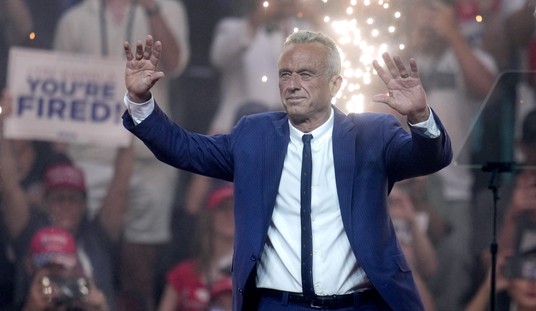






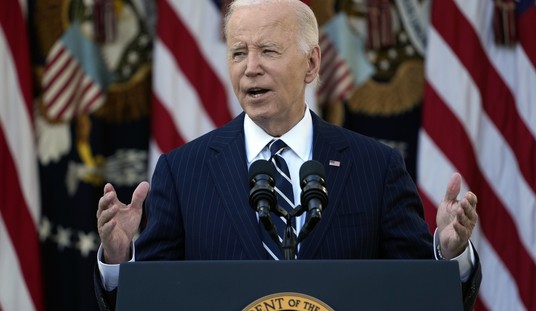


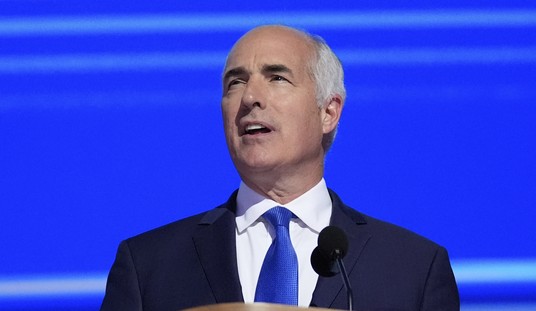
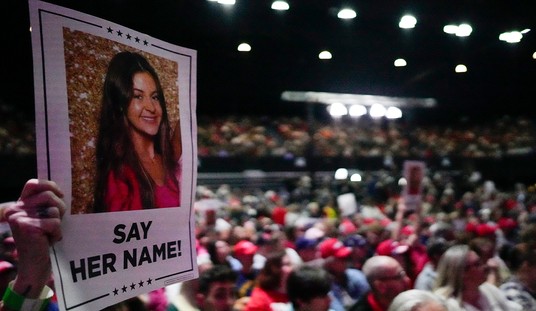

Join the conversation as a VIP Member